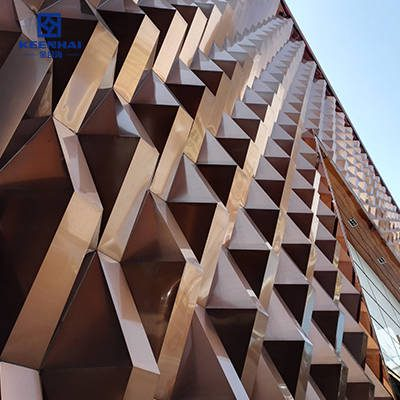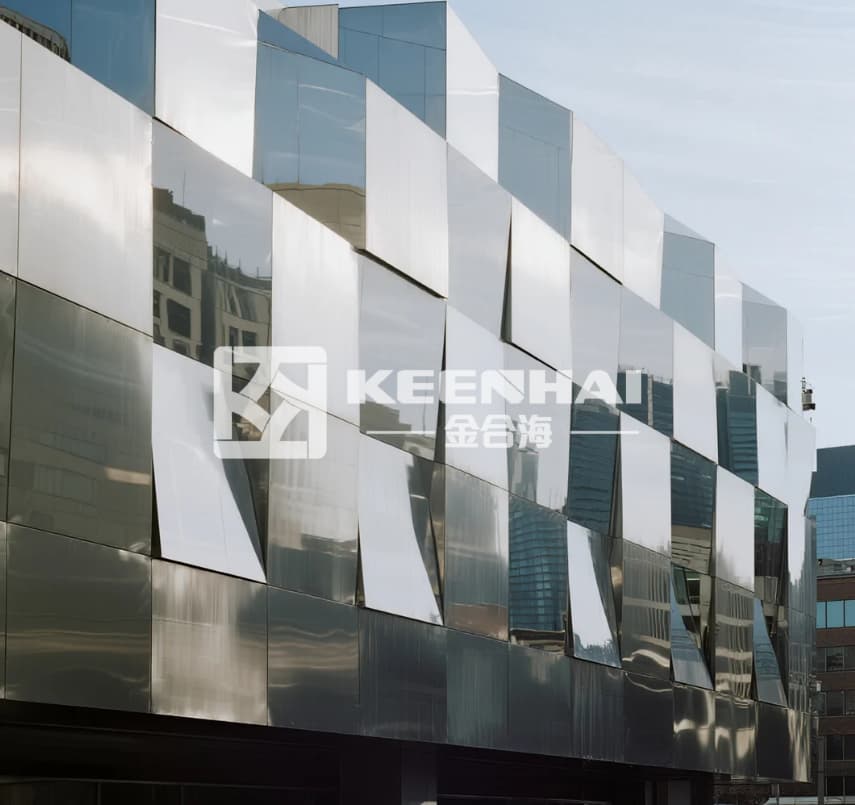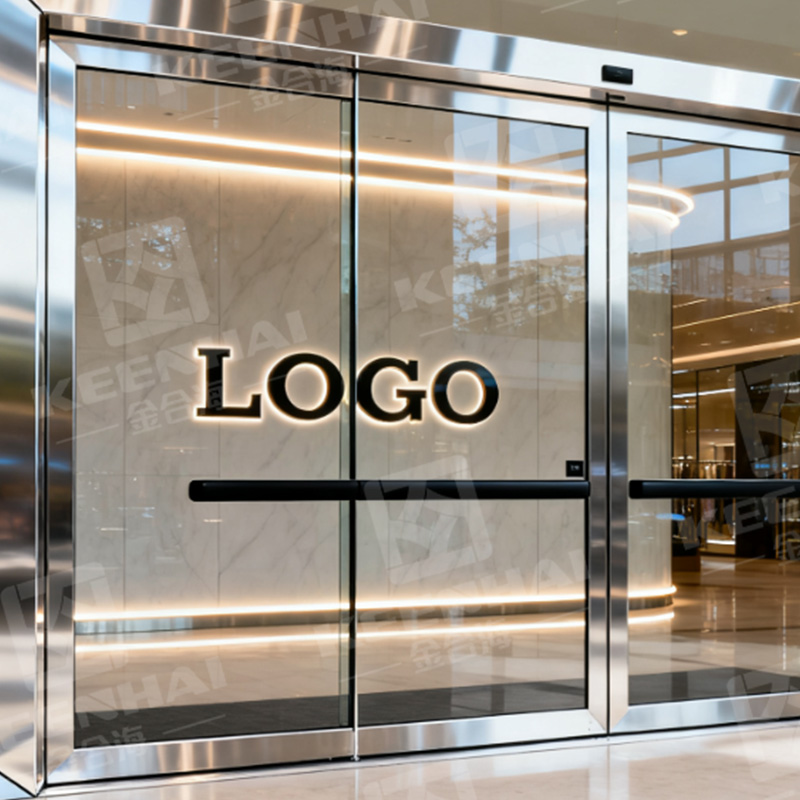Both 304 ಮತ್ತು 316 stainless steels are strong, easy to fabricate, and long-lasting. The key factor is resistance: 304 is enough for standard use, but if the environment includes salt, chemicals, or high humidity, 316 is the safer and longer-lasting option.
1. Chemical Composition
1.1 Chromium and Nickel Content
The backbone of both 304 and 316 grades lies in their chromium and nickel balance. Type 304 generally contains about 18–20% chromium and 8–10.5% nickel, giving it strong oxidation resistance and durability. In contrast, 316 holds a slightly higher nickel range of 10–14%, which stabilizes the alloy and enhances performance under aggressive environments. Architects working on coastal buildings often lean on 316-grade decorative stainless steel because the added nickel gives it more stability when exposed to salty air.
| Grade | Chromium (%) | Nickel (%) | ಟಿಪ್ಪಣಿಗಳು |
|---|---|---|---|
| 304 | 18–20 | 8–10.5 | Standard choice for kitchens, facades |
| 316 | 16–18 | 10–14 | Better stability in marine projects |
1.2 Molybdenum Addition in 316
The real differentiator comes from molybdenum, which is absent in 304 but present at 2–3% in 316. This small addition significantly increases resistance to chloride-induced corrosion, making 316 the go-to material for seaside hotels, yacht interiors, or outdoor premium stainless steel sheet panels used on high-rise exteriors. The molybdenum not only shields against pitting but also maintains surface integrity over decades, even in humid or chemical-heavy settings.
1.3 Trace Elements and Their Roles
Aside from chromium, nickel, and molybdenum, trace elements like manganese, silicon, and nitrogen subtly influence performance. Manganese enhances tensile strength, while silicon improves oxidation resistance at higher temperatures. Nitrogen, present in controlled amounts, boosts strength without sacrificing ductility. For example, when an airport terminal specifies large ಸ್ಟೇನ್ಲೆಸ್ ಸ್ಟೀಲ್ ಬಾಹ್ಯ ಗೋಡೆ panels, engineers consider these trace elements to ensure the cladding remains both structurally sound and visually clean over years of heavy traffic and varying climates.

2. Corrosion Resistance
2.1 Performance in General Environments
Type 304 stainless steel has long been the workhorse in architectural and industrial settings because of its reliable resistance to oxidation in day-to-day environments. A shopping mall using premium stainless steel sheet panels for interior wall cladding can safely choose 304 without worrying about staining from ordinary cleaning chemicals or food contact. With its balance of chromium and nickel, 304 maintains its metallic luster even in areas with fluctuating humidity.
However, when installations move outdoors, subtle differences emerge. Rainwater, urban pollution, and seasonal humidity cycles can introduce more aggressive factors. In these cases, 316 stainless steel demonstrates a noticeable advantage. The extra nickel stabilizes the passive film, making it less likely to develop surface spots. Office towers that feature ಸ್ಟೇನ್ಲೆಸ್ ಸ್ಟೀಲ್ ಬಾಹ್ಯ ಗೋಡೆ cladding often rely on 316 when the building is located in regions with acid rain or higher levels of industrial pollution.
In practice, both alloys provide strong resistance to general wear, but their behavior diverges under long-term exposure. Museums and cultural centers with high visitor traffic often select 304 for handrails and elevator trims, where contact is constant but the risk of aggressive corrosion is low. Conversely, when the installation site is an outdoor plaza, developers lean toward 316 to ensure the structure retains its clean, professional look without unexpected maintenance costs.
2.2 Resistance to Chlorides and Marine Conditions
The real challenge for any stainless alloy comes from chlorides. Saltwater and de-icing salts attack the passive chromium oxide layer, exposing the metal to localized corrosion. Here, 316 stands apart because of its 2–3% molybdenum content. This small but crucial addition makes a dramatic difference in performance.
Imagine a seaside hotel that installs decorative stainless steel metal cladding facade panels on its balconies. If those panels are made of 304, it may take only a few years before small brown rust spots appear near crevices where salt spray dries. In the same scenario, panels fabricated from 316 retain their smooth finish, even after repeated storm seasons. Yacht interiors provide another example. Galley counters and railing components built with 316 remain spotless despite continuous exposure to salt-laden air, while 304 equivalents would require far more frequent cleaning and replacement.
When it comes to chloride stress cracking, 316 also demonstrates higher resilience. Public swimming pools, where water contains chlorine disinfectants, are notorious for creating corrosion issues in structural fasteners. Engineers have documented that bolts and anchors manufactured from 304 often suffer cracking within a few years, while 316 components withstand the same conditions for decades.
| Environment | 304 Stainless Steel | 316 Stainless Steel |
|---|---|---|
| Coastal Air | Prone to surface rust spots | Maintains smooth finish |
| Chlorinated Pools | Stress cracking likely | Much higher resistance |
| Urban Settings | Adequate | Excellent durability |
2.3 Pitting and Crevice Corrosion Differences
Pitting and crevice corrosion represent two of the most insidious forms of attack on stainless alloys. They don’t spread across large areas but instead create deep, localized cavities that can compromise structural integrity. 304, while sufficient for dry or lightly humid conditions, struggles when water stagnates in tight spaces. Drainage channels under a metal stainless steel sheet roof, for example, are vulnerable if fabricated with 304. The small stagnant pools allow chlorides to concentrate, quickly leading to visible pits.
316, with its molybdenum reinforcement, resists this localized attack. Laboratory tests show that the critical pitting temperature of 316 is significantly higher than that of 304, meaning it can endure harsher conditions before breakdown occurs. This translates directly to real-world benefits. Underground transit stations using 316 for handrail fasteners avoid the hidden crevice corrosion that would otherwise require costly replacements. Similarly, luxury residential complexes with exterior canopies built from 316 cladding report far fewer issues over decades of use.
To minimize crevice attack during construction, architects and contractors often take additional measures:
-
Design joints that avoid stagnant water accumulation.
-
Use sealants or gaskets to prevent chloride ingress in narrow gaps.
-
Select 316 for locations exposed to repeated wetting and drying cycles.
These preventive steps, combined with the inherent strength of 316, ensure long service life for structures that depend on stainless components as both functional and aesthetic elements. From bridges with decorative balustrades to public waterfront promenades, the choice of grade makes the difference between a surface that quietly resists the environment and one that demands constant upkeep.

3. Mechanical Properties
3.1 Tensile Strength and Hardness
Both 304 and 316 belong to the austenitic stainless steel family, which means they share many baseline mechanical properties. In terms of tensile strength, both grades average around 515 MPa, while yield strength is typically near 205 MPa. Brinell hardness generally sits below 201 HB for both alloys, which makes them relatively ductile and easy to shape compared to harder martensitic steels.
Although the numbers look similar, context matters. For instance, when installing premium stainless steel sheet panels in a convention center, engineers choose between the two grades not because one is significantly stronger than the other, but because of environmental demands. A handrail system fabricated from 304 performs well indoors, but for the same railings placed outdoors in a coastal boardwalk, 316 is selected to combine equivalent strength with better corrosion resistance.
In heavy-use projects like airport terminal counters, designers often prioritize hardness and wear resistance. Both grades can withstand continuous contact without surface deformation, but 316 tends to hold its polish slightly longer, especially under abrasive cleaning regimes.
| Property | 304 Stainless Steel | 316 Stainless Steel |
|---|---|---|
| Tensile Strength (MPa) | ~515 | ~515 |
| Yield Strength (MPa) | ~205 | ~205 |
| Hardness (HB) | ≤201 | ≤201 |
3.2 Heat Resistance and Operating Temperatures
When it comes to heat, both alloys can tolerate elevated operating temperatures, but they behave differently under long exposure. 304 stainless steel maintains structural stability up to about 870°C in intermittent service and 925°C in continuous service. However, prolonged exposure in the 425–860°C range can lead to carbide precipitation, weakening corrosion resistance. This becomes critical in architectural kitchens or public catering halls, where oven surrounds or high-heat cooking equipment use stainless steel metal plate. In such scenarios, 304 works well but may need stabilization techniques if constantly heated.
On the other hand, 316 performs reliably at slightly lower maximum service temperatures (about 870°C intermittently and 925°C continuously), but it provides better oxidation resistance in moist heat or acidic steam. This makes it valuable in industrial kitchens, breweries, or spa facilities where humidity interacts with heat. For example, spa resorts that install 316 cladding near steam rooms report far fewer cases of surface dulling compared to 304.
Contractors also take note of thermal expansion when using large-format panels. In exterior canopies exposed to direct sunlight, 316’s resistance to warping under repeated heating and cooling cycles reduces maintenance costs. That explains why some stadiums in hot climates prefer 316 for roofing structures where both heat resistance and corrosion control are equally important.
3.3 Weldability and Fabrication Ease
Both 304 and 316 are renowned for their excellent weldability, which explains why they dominate architectural projects requiring large custom assemblies. Whether it’s curtain walls, elevator interiors, or ಸ್ಟೇನ್ಲೆಸ್ ಸ್ಟೀಲ್ ಬಾಹ್ಯ ಗೋಡೆ panels, fabricators can rely on these alloys to handle complex joints without excessive cracking.
Still, differences emerge once we look at post-weld performance. 304 is easier to weld and generally requires fewer adjustments, making it cost-effective for bulk production of cladding sheets. However, welded areas can become more prone to corrosion if the structure is later installed in a harsh environment. That’s why, in high-end façades exposed to coastal air, welders often recommend 316 despite its slightly higher fabrication cost.
In practice, fabrication usually involves three stages:
-
Cutting and forming – Both alloys can be laser-cut or roll-formed into customized profiles for façades, balustrades, or roofing.
-
Welding and joining – MIG or TIG processes are typically used. With 316, welders may choose filler metals with additional molybdenum to preserve corrosion resistance.
-
Finishing – Surfaces are polished or brushed to architectural standards. In urban skyscrapers, brushed 316 cladding has become a hallmark of modern design because the finish remains consistent even after years of exposure.
A good case study is the construction of an international airport terminal where thousands of square meters of metal stainless steel sheet were used for wall coverings. Contractors selected 304 for the indoor boarding gates due to easier fabrication and cost efficiency. For the exterior arrival canopy, however, 316 was chosen to ensure welded joints wouldn’t deteriorate from constant wet-dry cycles brought on by tropical rainstorms.

4. Cost and Availability
4.1 Raw Material Price Differences
Price is one of the most noticeable differences between 304 and 316. The base reason lies in their alloying elements. Nickel, already expensive, plays a central role in both grades, but 316 contains more of it, usually around 10–14% compared to 304’s 8–10.5%. On top of that, 316 requires 2–3% molybdenum, another costly element with volatile global pricing. These additions make 316 consistently more expensive than 304, often by 20–35% depending on market conditions.
For contractors bidding on public projects such as metro stations, these percentages translate into significant budget differences. For instance, if a station concourse requires 5,000 m² of premium stainless steel sheet panels, the choice between 304 and 316 could shift the material cost by hundreds of thousands of dollars. Developers often weigh this gap against the potential expense of future maintenance. While 304 might look like a money-saver upfront, 316’s reduced upkeep can make it more cost-effective in the long run, especially in humid or marine-influenced climates.
| Alloy | Average Market Price (USD/kg) | Cost Impact in Large Projects |
|---|---|---|
| 304 | $2.5–$3.0 | Preferred for interiors, bulk orders |
| 316 | $3.2–$4.0 | Higher initial cost, lower long-term upkeep |
4.2 Market Availability of 304 vs 316
Availability plays just as big a role as pricing. Grade 304 is produced on a massive scale worldwide, which explains why it’s often the first recommendation from suppliers. Almost every warehouse that stocks stainless carries 304 in a variety of forms: coils, plates, bars, or decorative stainless steel metal plate for architectural use. Its widespread production ensures quick delivery times, which is critical for fast-track projects like mall renovations or airport expansions.
316, though slightly less common, is far from rare. It tends to be stocked in coastal cities and industrial hubs where demand justifies the higher inventory cost. In practice, this means that if a contractor in New York or Singapore specifies 316 cladding for a waterfront hotel, suppliers can usually deliver within days. But if a project in a landlocked region requests 316, the order may involve longer lead times and higher shipping costs.
Architectural case studies often highlight these differences. A hospital expansion in Chicago opted for 304 for its new atrium interior since the material was immediately available in the required brushed finish. Meanwhile, a marina complex in Miami demanded 316 for its exterior façade panels; suppliers there had ample stock on hand, reflecting the local demand shaped by the coastal environment.
4.3 Long-Term Value vs Initial Cost
The most important financial decision lies in weighing initial purchase price against lifecycle value. On paper, 304 is more affordable, which tempts developers to choose it for large-scale cladding or roofing systems. Yet once ongoing cleaning, occasional replacement, and potential early deterioration are factored in, 316 often proves the smarter investment.
To illustrate, consider a waterfront office tower. The project team had two options:
-
Install 304 ಸ್ಟೇನ್ಲೆಸ್ ಸ್ಟೀಲ್ ಬಾಹ್ಯ ಗೋಡೆ panels at a 25% lower upfront cost.
-
Use 316 cladding, accepting the higher initial expense.
Within five years, the 304 façade began to show corrosion streaks around joints where rainwater collected. Cleaning and refinishing contracts added up quickly, nearly erasing the savings from the cheaper alloy. In contrast, comparable towers clad in 316 required only routine washing, maintaining a flawless surface that impressed tenants and investors.
Contractors often calculate lifecycle costs using 20–30 year projections. Even though 316 requires a larger budget at the start, reduced maintenance contracts, longer intervals between refurbishments, and higher resale or rental value make it attractive for landmark projects. In luxury real estate and high-profile public buildings, developers frequently justify the expense by marketing 316 cladding as part of their premium design language.
Already decided between 304 and 316? Take the next step and lock in color + extra corrosion resistance with our PVD stainless steel sheet guide.






